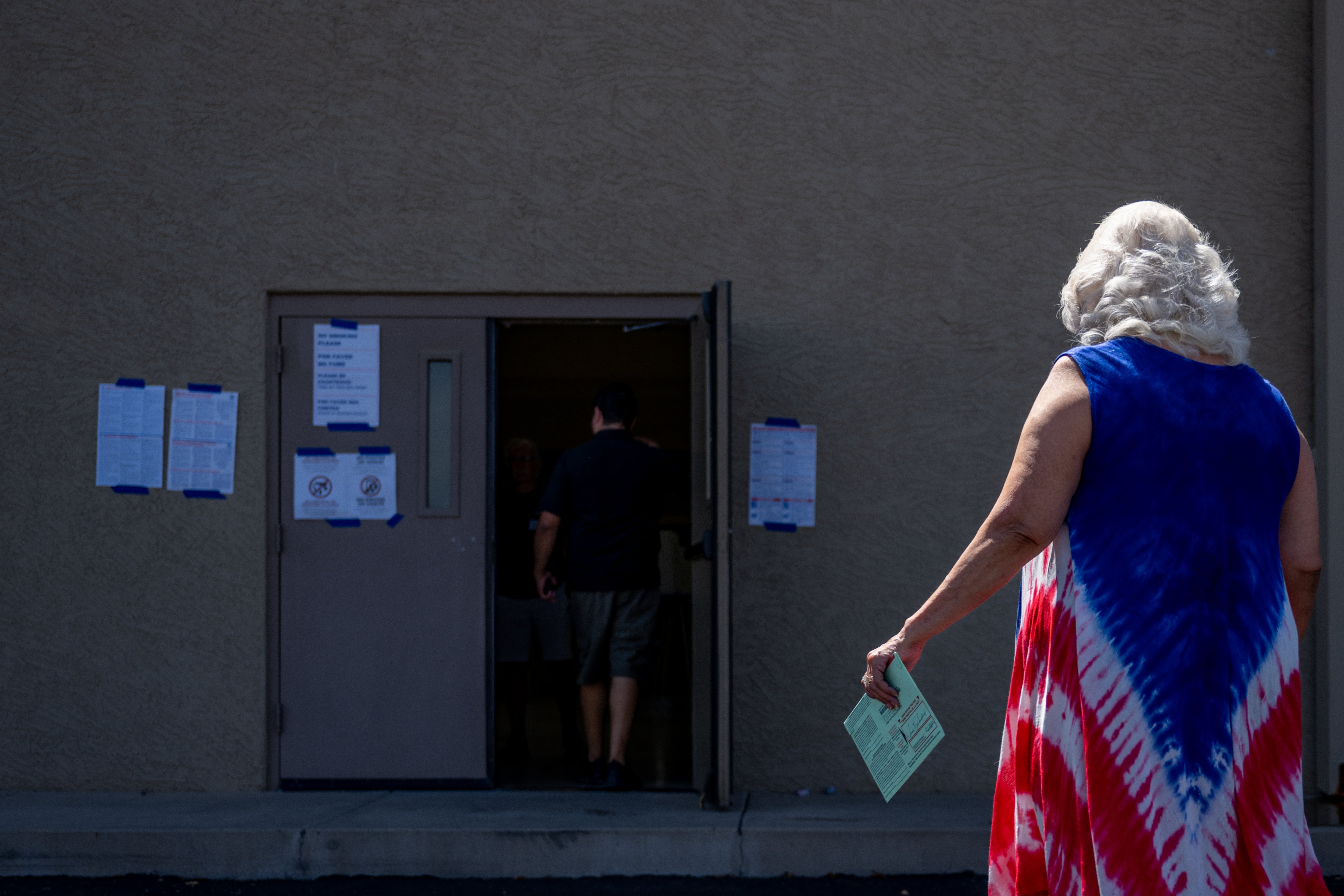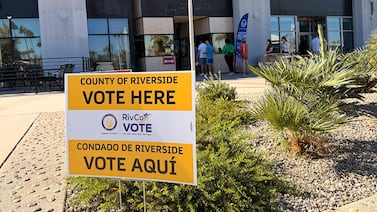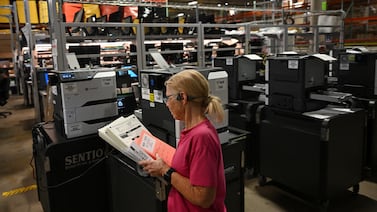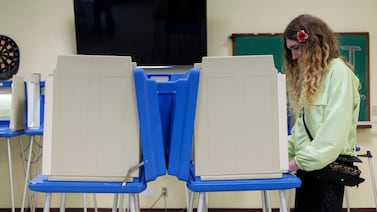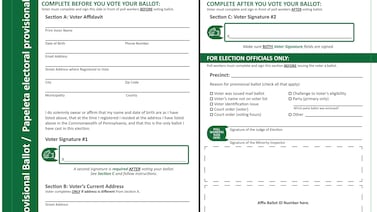Voter advocates are warning it will be hard for Maricopa County voters to read and understand their midterm ballots, because the county is using small text sizes to accommodate an extraordinary number of election contests.
The various text sizes on the county’s 20-inch-long ballots go as small as 7.5 points, well below the 10-point or 12-point standard recommended by ballot design researchers and voting rights organizations. Anything below the recommendation is challenging for all voters to read, according to the experts, not just for those with poor eyesight.
The smaller the text, the more difficult it is to understand what you’re reading, according to cognitive research. The length of the ballot varies throughout the county, depending on the precinct. But with an average of 80 contests on the ballot, including many complicated statewide ballot measures proposed by lawmakers, voters may get discouraged, but it’s important they read closely, said Pinny Sheoran, president of the League of Women Voters of Arizona.
“This is truly Read the fine print, everyone,” Sheoran said.
The ballot measure text — in complicated language and lengthy blocks — is among the smallest on the ballot, at 8-point type.
Some states ban small text outright. In Wyoming, text must be ⅛ inch high, which is about 9 points. In Washington, the recommended text size is 12 points and the minimum allowed is 8 points. In Florida, text size on ballots must be at least 10 points.
Arizona law requires ballot measure numbers, which serve as section headings, to be printed in 12-point font, which Maricopa County has done. There are no other rules regarding text size, although it says that the text must be “no less than 8-point font if practicable.” Despite that, this year’s ballot instructions fall below that on this year’s ballot, at 7.5 points.
In some states, Florida especially, county administrators switch to multiple-card ballots to fit everything if necessary. In Arizona this year, Pinal County’s ballot is two cards. But multiple-card ballots create a logistical nightmare for administrators trying to count and track ballots, said Mark Earley, supervisor of elections in Leon County, Florida.
Maricopa County Elections Department spokesperson Megan Gilbertson said a two-card ballot would have cost more, caused voter confusion, and increased the time needed to print ballots at polling places.
She said ballot design is a complex process, much of which is dictated by state law. The county offers several accommodations — including allowing voters to request a large-print mailed ballot, providing sample ballots online so voters can zoom in on language, and offering accessible voting machines at polling places for in-person voters.
They have magnifying glasses available, too.
Some Font Sizes Down From Last Two Elections
By now, Maricopa County voters are used to seeing pretty small type sizes.
In 2018, contest and office titles other than the proposition headers were in 9- or 10-point font. In 2020, the county shrunk down some headings and the ballot instructions. For this election, some headings got even smaller, while one heading type got larger. The largest type size on the ballot is 9 points, other than the ballot measure headings.
Best practices call for fonts of more than 10 points, said Whitney Quesenbery, director of the Center for Civic Design. Guidelines put out by the U.S. Election Assistance Commission and developed by experts with AIGA, the Professional Association for Design, recommend even larger type, at 12 points.
Vote-counting machines must, under federal law, be able to read above anything 10 points and above, Quesenbery said, and there’s a reason that was set as the standard.
“When you get below 10 points, that’s when it starts to feel small, it starts to feel hard,” she said. “It’s likely to make people feel like they aren’t able to read.”
To ensure voters with vision loss can navigate a ballot, Direct Advocacy & Resource Center, a Tucson-based nonprofit that advocates for disability rights, recommends no smaller than 12-point text, said Vicki Cuscino, the organization’s executive director.
“Voters with low vision can be any age, but we know that many older/aging adults may fit into this category,” Cuscino said.
Quesenbery said she understands officials are under constraints that make it difficult to design their ballots, “But at the end of the day, as a designer, I want to see the finger on the scale weighing on the side of voters, so voters are able to understand the ballot, understand the questions they are asked, and vote their intent.”
How Voters Can Be Prepared
This year’s ballot is the longest yet, at 20 inches. In recent years, primary and general election ballots have been 18 or 19 inches. The ballot with the most contests this year is in a Mesa precinct, with 87 contests. The sheer number of contests made it difficult to fit everything on the ballot not just in Maricopa County, but across the state. There are 10 statewide propositions, two of which have a mandatory 53-word paragraph explaining that the measures can’t be changed if they are approved except in certain circumstances.
Sheoran said she is used to seeing about four or five propositions on the ballot, but not 10. Of the 10, eight were proposed by lawmakers, not voters.
“Having very small, tiny print of laws being brought forward — eight of them by legislators — makes me raise a red flag if you will,” she said.
Sheoran said the ballot “needs to be readable by everybody,” and she believes it would be a discriminatory practice to make the text so small that people who aren’t visually impaired still need assistance with a visual tool.
She suggests that voters having difficulty reading their ballots at home visit the League’s voter guide at vote411.org, where they can look up information about all of the contests on their ballot. Voters going to the polls in person should look before they go, she said.
At the polling places, the county has enlarged ballot instructions posted inside each voting booth, offering an easier way to read the text.
Maricopa County voters can request a large text ballot, with a minimum of 18-point font, on the election departments’ website. Not many voters take advantage of this service: 531 in the 2020 general election and 590 in the 2018 general election.
They also can go online to beballotready.vote and see a sample ballot, which they can then save and zoom into the contests to see more clearly.
Quesenbery said voters who are struggling to read their ballots at the polls should use the accessible voting device, which is required by state law to be at every polling place. More people should take advantage of that, she said. The machine puts one contest on the screen at a time in large text, reducing the clutter.
All voter advocates stress the importance of studying the ballot before you vote.
“An informed voter is a powerful voter,” Sheoran said.
Did the County Have Another Option?
The most troubling logistical problem with a multiple-card ballot is that often, people only return the first page, which typically has the most well-known state contests. Counties frequently use the number of cards cast to determine the number of voters who voted, comparing it with results as a way to double-check everything. If the voter doesn’t send all the cards back, it’s harder to keep track of the total number of voters.
Gilbertson said that while Maricopa County is always looking for ways to improve, moving to a two-card ballot would “be more expensive, create longer lines and provide more voter confusion rather than less.”
Pinal County Recorder Dana Lewis said county election officials came up with a system for poll workers that would still allow them to properly track the number of voters. But she acknowledged this complicates an already-complicated process even further.
The county offers a bilingual ballot instead of having voters pick a ballot featuring their preferred language. It would have been impossible to fit everything on one card, Lewis said, even though there are fewer contests there than in Maricopa County.
In Florida, Earley said the last time his county had a two-card ballot, in 2012, about 10,000 out of 150,000 voters in his county, or about 7 percent of voters, didn’t return the second card of the ballot, despite communication reminding voters that it is important. The county figured out a workaround, but it still makes it more difficult.
There are many other factors that go into the decision to move to two cards, Earley said. If you use too long a ballot, for example, Earley said, sometimes there are too many folds and the vote-counting machines have trouble reading them. Or the storage boxes could be too small.
Earley said voters there complain about the 10-point text being too small. Any smaller, he said, and “it gets the point that filling out a ballot is like completing a mortgage.”
Jen Fifield is a reporter for Votebeat based in Arizona. Contact Jen at jfifield@votebeat.org.

